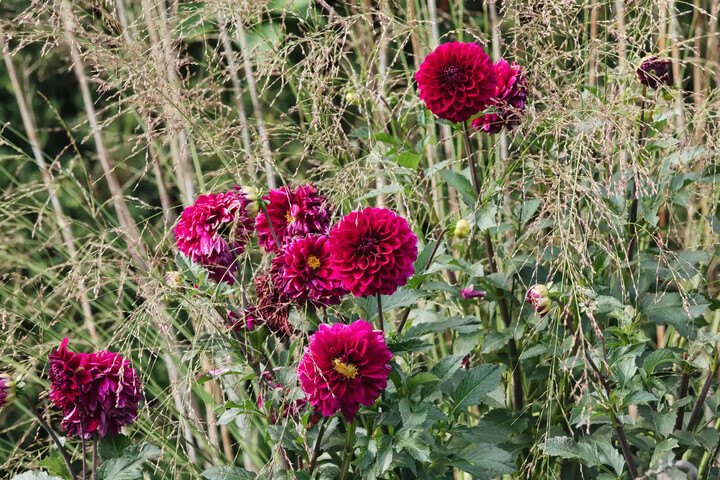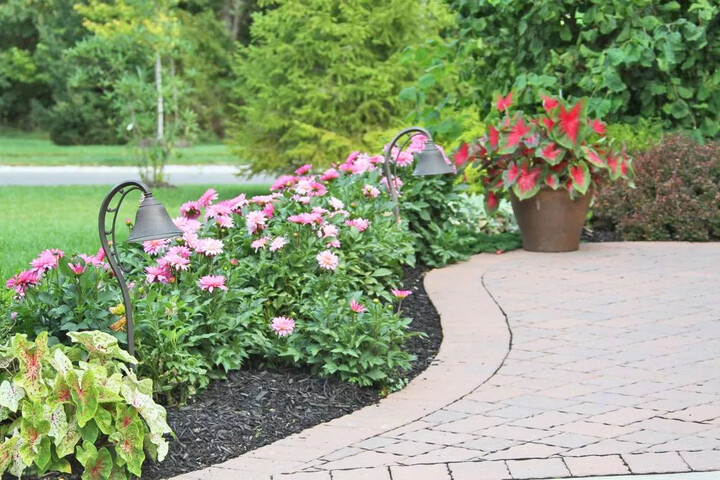Dahlias are mid- to late season flowers that come in a vast array of colors and forms. There are small flowered bedding dahlias as well as plate-sized blossoms on 6 ft. plants. It's hard to give an overview of dahlias when there is so much diversity.
Dahlias are often grown for their long-lasting cut flowers. There are some 30 species of dahlias and over 20,000 cultivars. Native to Central America, they have become darlings of plant breeders and flower shows and every year they become more dazzling.
Most of us think of dahlias as cut flowers. They do make exceptional cut flowers, but they also deserve some recognition as garden plants. Although they can be a little temperamental and fussy about the weather and growing conditions, many of the newer cultivars have been bred to be more reliable and easy growing.
In particular, the shorter, stockier bedding series with large-sized blooms, like Gallery and Impressions, are proving very dependable. Hans likes them best in large clumps, saying that when spaced about 20 in. apart, a clump of 3 - 5 will grow into a dahlia bush.
They are often labeled as perennials, but they are actually too tender to leave out all winter, in all but the warmest climates. Which means you either have to dig and store the tubers or grow them as annuals and replace them each year.
Dahlias are tubers, not bulbs and, as mentioned, they are not cold hardy and cannot be left in the ground over winter, where temperatures go below 20 degrees F. (6.5 C). That is why they are generally planted in the spring and dug and stored in the fall.
- Leaves: Generally the mid- to dark green leaves are pinnate, meaning they flair out like a feather. They usually have toothed margins and rounded tips, although the cactus and lacinated varieties tend to be more finely cut.
- Flowers: The forms and colors of the flowers vary with the classifications. For more on that check out classifying dahlias.
Botanical Name
Dahlia cultivars
Common Name:
Dahlia
Hardiness Zone
Hardiness depends on the cultivar, but most are only reliably hardy in USDA Hardiness Zones 8 - 11. Most gardeners grow them as tender bulbs or annuals.
When asked if there was an ideal climate for dahlias and should gardeners in different zones choose different varieties, Hans said that although they are native to the hot climate of Mexico and Central America, they will grow just about anywhere. In fact, hot climates can be a challenge because the dahlias will need extra water.
Sun Exposure
To flower well, dahlias need full sun, preferably at least 8 hours. In hotter climates, (Zones 8 and up) they will do better with some afternoon shade.
Mature Plant Size
Size varies greatly between varieties. The smaller dahlias grow only 6 - 8 inches tall and the dinner plate dahlias can get well over 5 ft.
Bloom Period
Mid-summer through frost. Many can handle a light frost and keep blooming.

Dahlia Growing Tips
To start your dahlia plants off right, consider where and how you plant them.
Soil for Dahlias: Dahlias like a rich, well-draining soil with plenty of organic matter and a fairly neutral soil pH around 6.5
If you are planting your tubers in containers, mix in 1/3 garden soil, for better moisture retention. Potting soil dries out quickly and the tubers need to stay moist until they have sufficient roots.
Planting Dahlias: You can get a head start on the growing season and pot up your tubers in late spring, to transplant outdoors after all danger of frost. The downside to this is that you'll need large pots and lots of space. Or you can direct plant the tubers in the garden. Wait until the soil has warmed and dried a bit in the spring, before planting. They can be planted a couple of weeks before your last frost date, as long as the soil is not wet.
Dahlias can also be propagated by seed or cutting. Only the small flowers bedding dahlias do well from seed, and even they don't grow true. If you'd like to try growing them from seed., sow it early, indoors in February or March. Cuttings are a better option if you can keep them warm and growing all winter.
Plant large tubers about 6 - 8 inches deep. The smaller varieties can be planted 3 - 4 inches deep. Only fill the holes a couple of inches deep so that the crowns are just buried. As the plant grows, fill in the rest of the hole.
All the large flowered varieties will need room to branch out as they grow. Spacing them about 20 - 24 inches apart should do it. Hans also advises that you stake them while you're planting. With all those large flowers, most varieties will need some type of support.
Any type of tall stake is fine. There are special stakes that circle around individual stalks, but you can wrap twine around wooden stakes or use tall tomato cages. Three to four 5 ft. bamboo stakes surrounding the plant will hold it upright if you circle twine around them 1/3 and 2/3s of the way up.
Caring for Dahlias
Mulching will help keep the roots moist. They are shallow rooted and can dry out quickly. Once the plants bush out and cover the soil, it should be less of a problem.
The tubers need to store up energy during the summer, to get them through the winter. A mid-season application of an organic flower food will give them a boost. Whatever fertilizer you choose, look for one with a low nitrogen ratio. Don't fertilize after August. You are going to be digging and storing the tubers soon and you want them ready to go dormant.
A lot of growing information says to pinch the growing tip, to encourage multiple stems. Hans says that is not necessary and will actually reduce the size of the mature plant. Instead, he recommends removing only the first flower bud. That will be enough for the plant to branch out.
If you are looking for the largest flowers possible, Remove the two side buds that form around the central bud. The central bud will produce the biggest flower and it will be larger still if the two side buds are not left there to compete for nutrients.
Finally, keep cutting your dahlias. Even if you don't want them for arrangements, be sure to deadhead them or blooming will diminish.
Digging and Storing Dahlias: Wait until a frost hits your dahlias and the leaves blacken before you dig them up to store. You'll find information on how to do that on in Dividing Dahlias and info on storing all types of non-hardy bulbs and tubers in storing tender bulbs
Dahlia Pests & Problems
- Insects: The biggest pest is definitely slugs, especially while the dahlias are young and small. Earwigs, caterpillars, and thrips can also pose a problem.
- Deer: Some people say deer love their dahlias and others claim they avoid them. Perhaps it depends on what else is available to munch on, but keep your plants protected, just in case.
- Diseases: Dahlias can be prone to powdery mildew and other fungal diseases. Keep the foliage as dry as possible by allowing for good air circulation. More serious are leaf spot and dahlia wilt and viruses. Plants with viral infections often manifested by leaves that yellow in an irregular pattern, should be destroyed. There is no cure and the virus will spread.
Designing with Dahlias
Suggested dahlia varieties:
- "Alauna Clair-Obscur": A twisted cactus dahlia with a deep purple center that flairs out to fuchsia circled in white.
- "Bodacious": An informal decorative dahlia with truly plate-sized ruffled flowers of orange-red, with yellow accents.
- "HS Flame": A striking plant with dark purple foliage, salmon petals around a dark center disk with a yellow halo. This is a single-flowered Mignon dahlia.
- "Serenade": One of the Galley dahlias. Only about 2 ft. tall, but loaded with buttery yellow flowers. Good choice for containers.
- "Serkan": - A lilac petaled waterlily dahlia with 4 - 5 in. Monet worthy flowers.
Design Suggestions
Since dahlias need room to spread out, it can be difficult to pair them with other plants. However, they do tend to get gangly legs and having some camouflage at their base is not a bad idea. A good place to tuck in dahlias is near the fading foliage of spring bulbs, like daffodils and tulips. The dahlias should sprout just when you need a distraction from the fading spring bloomers, but still be short enough to allow the spring bulbs to get the sunshine they need.
For actual camouflage, you will need taller plants. Annuals, such as saliva, artemisia, and four o'clocks, are good choices. They are generally ready to plant shortly after the dahlias sprout and bloom about the same time, so keep colors in mind. Planting the annuals in front of the dahlias will keep them from being engulfed by the larger plants. The four o'clock have the bonus of attracting aphids and Japanese beetles away from the dahlias. A mixed blessing.
You can also grow dahlias in containers. They grow well in pots and you can get them started earlier than in the ground. Try 2 - 3 plants in a container that's at least 15-20 inches in diameter.
The largest blooms will come from cactus or dinner-plate dahlias. Dinner-plate dahlias are actually classified as Decorative. To get the flowers dinner-plate-sized, you need to start with large tubers, labeled AA, and pinch off almost all buds and stalks, so the plant focuses all its energy into a handful of shockingly large blooms. Start when the plant is about 1 ft. tall. Pinch out the tips of the growing shoots at a leaf axil. Repeat this pruning when side branches fill in. Then remove all side flower buds, as they form, leaving only the main terminal bud.
Of course, you could just let the plant flower normally and enjoy large, though not dinner-plate sized flowers all season.
Cutting Dahlias: Cut dahlia stems when the central flowers are fully opened. Cutting in the morning, when the plants are full of water, will give you the longest lasting cut flowers. Bring a bucket of water with you, when you cut, to plunge the stems into. Take a long section of stem. The stems are sturdy and will make great arrangements.
When you get them indoors, plunge the stems into 2 - 3 inches of hot (not boiling) water, to seal them. Leave them there until the water cools.
The unopened side and lower buds may bloom after cutting, but don't worry if they don't, your plant will be setting more.
